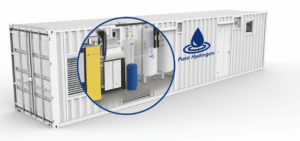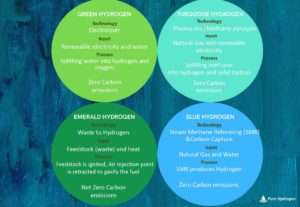You might be interested in
Energy
Pure Hydrogen’s green hydrogen micro-hub strategy is taking off
Energy
Pure Hydrogen unlocks value with strategic asset sale to accelerate development of its hydrogen business
Energy
Energy
Pure Hydrogen’s strategy is to develop large scale hydrogen plants on the east coast of Australia, and become a one-stop shop supplier in the hydrogen economy.
Pure Hydrogen (ASX:PH2) is an Australian east coast focused clean energy company with hydrogen and gas businesses.
Part of its strategy to become the largest hydrogen producer in Australia is to develop large scale hydrogen plants on the east coast of Australia.
Currently, the company has five hydrogen projects under development, which includes Gladstone (Project Jupiter), Mackay (Project Mars), Port of Newcastle and Port Anthony (Victoria), and Project Venus in Queensland’s Surat Basin.
It also has three gas projects – Windorah Gas Project in the Cooper Basin, Australia’s most prolific onshore producing petroleum basin, Project Venus CSG in the Surat Basin, and the Serowe Project CSG in Botswana, in which PH2 has a 30% stake.
PH2 is targeting three potential markets for its hydrogen production – transport, power storage and generation, and the export market.
In transport, the company has signed partnership deals to provide transportation and refuelling services, as it aims to become a one-stop-shop supplier within the hydrogen economy.

In power generation, PH2 has just signed a deal with BotsGas to establish the Serowe Hydrogen Hub renewable energy business in Botswana.
The Hub will be targeting 50MW power generation, which will potentially enable the country to become energy independent from neighbouring South Africa.
On the export side, PH2 has chosen projects that are near the ports with transport hubs and established infrastructure.
These locations have been chosen specifically for the company’s export plans in mind, with Asia’s – especially Japan’s and Korea’s – markets in its sight.
Hydrogen production is currently experiencing widespread political and business momentum, with a number of policies and projects around the world expanding rapidly.
Global demand for hydrogen is forecasted to increase to 100 million tonnes by 2030, and exceed 500 million tonnes by 2050, which is a 10-fold increase from today’s volumes.
With hydrogen consumption continually rising in the region, Asia-Pacific has been the largest hydrogen market and is expected to witness the fastest industry growth moving forward.
In Australia, the federal government has vowed to spend an extra $539 million on new “clean” energy projects, which Prime Minister Scott Morrison says will create 2500 jobs and drive down greenhouse gas emissions.
This comes as US President Biden also pledged to cut US greenhouse gas emissions by 50% by 2030 and have a carbon-free power system by 2035
Studies have shown that hydrogen fuel cells have an advantage over conventional batteries, including faster refuelling and better range.
Hydrogen is also environmentally cleaner, and has a higher payload which is particularly important for long-haul vehicles like trucks.
Unlike private cars, which are looking at electrification in the near future, long-haul trucks are keener on using hydrogen as a renewable energy source.
The reason is that hydrogen is more suited to long-distance, cross-country journeys that heavy-duty trucks usually undertake, because travel routes on those vehicles are mostly predictable.
This means that refuelling infrastructure could be built along the already-known and highly-used highway routes.
The hydrogen fuel cell is also lighter than the batteries that are installed on trucks, providing better payloads.
Also when compared to diesel, hydrogen has advantages including lower fuel cost, and less noise.
The fuel cells can also go a further distance than diesel, as well as being lower maintenance for the engines.
PH2 is developing a hub strategy on the east coast of Australia, focusing on supplying local customers.
The supply of hydrogen comes from both larger plants, as well as smaller decentralised ones closer to customer’s sites.
To keep supply running, the company produces its own hydrogen, together with buying supplies from other parties.
The most recent supply agreement was with Wildfire Energy, which is converting waste to hydrogen and is also looking to develop a number of sites on the east coast.
Hydrogen is the universe’s most abundant element, but it doesn’t appear pure in nature, and requires energy to separate – which is expensive right now.
There are however several ways to produce hydrogen with zero or near-zero emissions.
PH2 has access to these processes, which include emerald hydrogen, turquoise hydrogen, blue hydrogen, and of course, green hydrogen.

The deal with Wildfire Energy is an example of emerald hydrogen, which is a process that converts waste and feedstock into hydrogen. The process involves igniting the feedstock, and retracting the air injection point to gasify the fuel.
Turquoise hydrogen involves splitting methane in a process called methane pyrolysis to produce hydrogen.
Blue hydrogen uses natural gas and water to power a Steam Methane Reforming (SMR) process, which provides nearly zero emissions.
Green hydrogen meanwhile, is the gold standard and uses an electrolyser process to split water into its components, oxygen and hydrogen.
This process is the cleanest in terms of emissions as it uses 100% renewable energy to power the electrolysation process.
This article was developed in collaboration with Pure Hydrogen, a Stockhead advertiser at the time of publishing.
This article does not constitute financial product advice. You should consider obtaining independent advice before making any financial decisions.